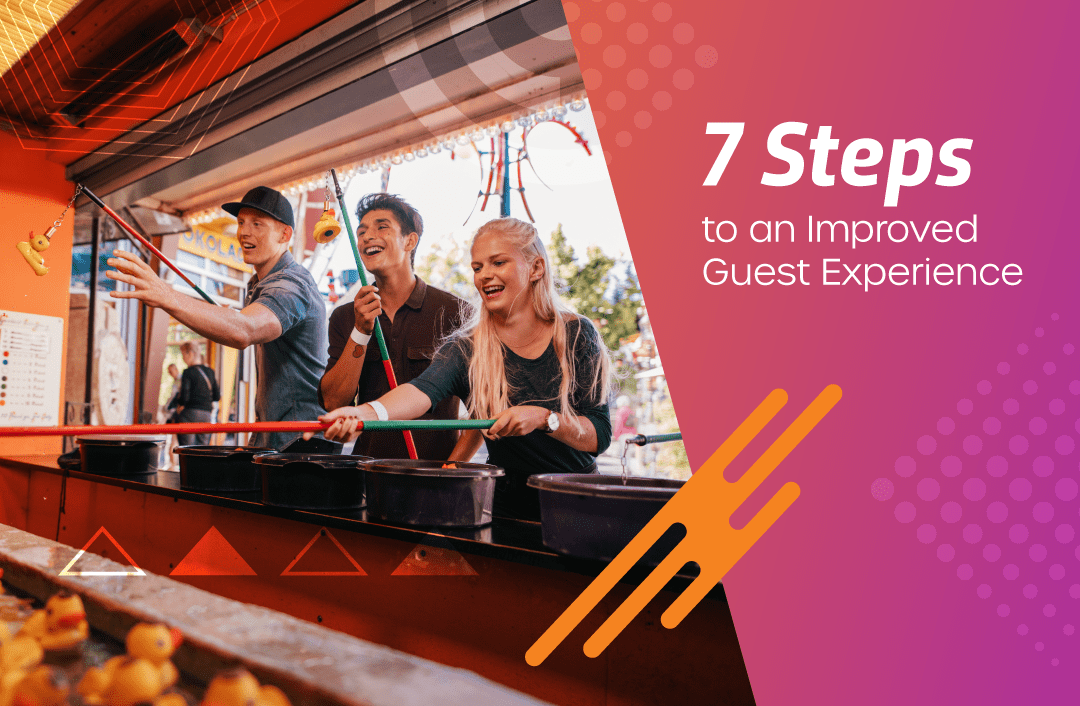Get ahead of the competition by implementing a rewards program that will have guests coming back again and again.
After our recent post about the benefits that a loyalty program offers an entertainment venue, we received a lot of requests for guidance about building compelling programs. There are so many options and directions you can take, and every facility has different needs. Use these seven questions to help you develop the program that’s right for your guests and your park.
No. 1: What is the primary objective of your loyalty program?
Be clear about the purpose your program will serve and use that objective as both a guide for development and a way to measure your program’s success. Two primary purposes are to encourage repeat visits, or to increase guest spending per visit.
Purchased Visit-Based Programs: If your business is a trampoline park with a lot of new local competition, for example, you might want to capture as much repeat business as possible to maintain and increase market share. A visit-based rewards program would allow you to incentivize guests after a certain number of visits.
In the past, these programs were simple cards that businesses would “punch” to show that a visit or purchase occurred. Every fifth or tenth transaction, for example, would earn a customer a free item, like a food or drink or a free admission.
Today, a visit-based loyalty program can be tracked on a player card, an RFID wristband, or even in your system’s customer profiles. Each time a guest visits, the first purchase that day will track the visit automatically until the award threshold for number of visits is reached. Awards, such as a free soft drink after five visits, could be printed and handed to a guest, or appear for a cashier to have a guest service touch point opportunity that might sound like, “oh, hey you’ve just earned a free soda, that’s awesome! Thanks so much for being a VIP with us!”
Sales-Based Programs: Any program is going to have at least a secondary objective of driving more repeat business, but a sales-based program is often implemented in venues where building per cap spending is the primary purpose. For example, if you operate a water park that offers season passes, a sales-based program that earned a guest rewards on number of dollars spent could encourage guests to spend a little more to achieve a new status tier and unlock additional benefits.
No. 2: How will awards tiers or achievements be structured?
When building a reward program of any kind, remember to keep it simple and easy for guests (and team members) to understand. If using a visit-based system, perhaps awards increase in value after admission purchases in increments of five or ten visits, to reward the most loyal guests with the most valuable items.
When implementing a points system based on sales, you might consider a simple one point per dollar spent for the entire program term or to increase points earned per dollar at elite tiers. A 1% return is very common, and is often used by credit card companies in the form of cash back, whereas many airline loyalty programs start with a 1% return and increase earnings as new tiers are achieved. For example:
Tiered Approach Earning:

No. 3: How will guests redeem their points?
Consider the value of both points awarded, the points required to purchase items, or both. But keep your thoughts on what will entice guests to return and purchase more often. Research states that consumers are, on average, enrolled in 14 loyalty programs but only fully engage with seven. Awarding small items after initial actions or purchases will help give immediate perceived value to your program, and then encourage future engagement by awarding more valuable items later.
After any initial bonuses, such as a BOGO or bonus points for enrollment and newsletter signup, perhaps you award a specific item once a tier is reached, like a free admission pass or large popcorn when a guest earns 100 points. Again, these awards can increase in value as spending limits are achieved.
Or, if $100 in sales equals 100 points, is it worth $1 in redeemable facility cash, or another amount? Perhaps you customize the points earned for certain purchases made, like awarding bonus points each visit, and 1 point per dollar spent for other items. The possibilities are virtually endless, so think through how often you would like to give rewards, the purchase price of those rewards and find the right balance between incentivizing and profitability.
No. 4: Can guests purchase all items you sell with rewards points or only certain items?
Many items that you sell can be configured to allow guests the ability to purchase with points. If you would like to receive an admission fee every time a guest enters, consider preventing admission ticket items from being purchased with points and offer guests merchandise or food and beverage items to purchase instead.
That said, to offer more flexibility, allow guests to purchase everything from admissions to food to merchandise with their points and have a ‘hassle free’ program. Consider not only what your guests will find valuable, but also those details that could be perceived as a program detractor. If it looks like there are many stipulations or exceptions, guests may decide your program’s “not worth the hassle” and abandon it.
No. 5: How will participants enroll in your program(s)?
Many facilities, especially those that use waivers and collect guest information at entry, automatically enroll guests into a loyalty program upon their first visit. This can be great to build a large program, but won’t necessarily equal high levels of engagement. Instead, you could have guests opt in at admissions with a cashier or in your online webstore, leaving participation up to the guest and potentially giving you a more engaged audience.
No. 6: How will you set the program time periods?
Think about a year or two down the road. Would you rather that a guest achieves a VIP status for life or for only a certain length of time? If choosing a finite program term, do you wish to set them per calendar year or set on a rolling period? A rolling 12-month term from the day of tier achievement would give guests a full year to enjoy all the tier benefits, and a spending requirement to remain in that tier on their achievement anniversary.
No. 7: Have you thought outside the box?
Like we mentioned, you have so many options when developing your loyalty program. Remember to take a step back as well and consider other offerings that might benefit from a value-added program.
For example, if you wish to add perceived value to your paid membership programs, you might consider a second rewards program in addition to your standard one. Perhaps members of a VIP membership earn double points for each transaction or a discount on concessions or merchandise. This enhanced reward could earn you more membership recurring revenue and more per visit spending so be sure to weigh these options when developing your programs.
Have a program in mind that you want to talk through? Interested in being featured in a CenterEdge case study showcasing your success? Let us know in the comments or on Twitter!
Search Resources
Subscribe to Email Updates
Featured Resources
News //
CenterEdge Chosen as Exclusive Software Partner for Launch Entertainment Growth Plan

Blogs //
How to Build Better Relationships With Your Guests

Blogs //
7 Steps to an Improved Guest Experience

Blogs //
5 Features of CenterEdge’s New Integration with Semnox

Posts by Topic
- Advantage Payments (7)
- Brand Management (19)
- Business Growth (81)
- Capacity Management (2)
- CenterEdge News (30)
- Client Interviews (9)
- Credit Card Processing (3)
- Data & Reporting (12)
- Digital Signage (1)
- Event Management (20)
- Facility Management (10)
- Food & Beverage (8)
- Guest Experience (34)
- Guest Management (20)
- Holiday Season & Promotions (5)
- Industry Events (12)
- Inventory Management (1)
- Loyalty Programs (8)
- Marketing Tips (24)
- Operations (1)
- Point of Sale (10)
- Product Launch (11)
- Productivity (5)
- Profitability (35)
- Redemption Management (1)
- Sales (35)
- Season Passes (1)
- Team Training (60)
- Waivers (2)

Leave a Comment